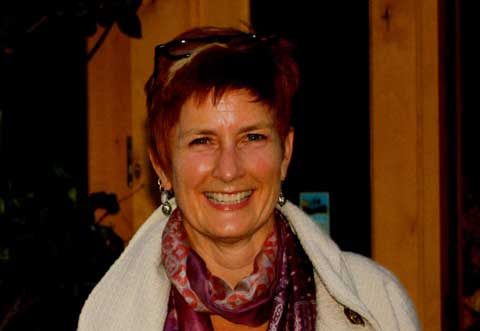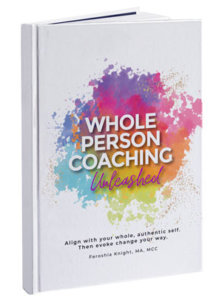Taking Change to A Whole New Level: Coaching Sales Professionals
Whole Person Coaching is designed to organically fit into the lives of individuals and businesses alike. When used for a combination of the two, we’ve seen some of our biggest success stories come to life. That’s because WPC is a comprehensive, easy-to-implement method that positions individuals to successfully market themselves, and their products or services, through a combination of interpersonal tools, competence, and confidence. With this level of support, a coach is able to stand out in even the most competitive marketplace, successfully and sustainably.
But before this shift can happen, the coach must peel back the layers of limiting beliefs that an individual has built up around a situation – beliefs that have often been established over a period of years. But whether used for business or personal benefit, the goal is the same: shift an individual’s perspective from transaction to connection.
A great example of this aspect of Whole Person Coaching is Amy Earle. A certified Whole Person Coach and professional salesperson herself, Amy has used the tools of coaching to rewrite her own story. That coaching experience ignited a passion in Amy to help a wide range of businesses and professionals, especially salespeople.
As we’ve established, the process is not an easy one, especially when a client is faced with something almost every salesperson fears at one time (and often continually): the dreaded cold call.
Here’s how Amy reframed her client’s fears and limiting beliefs… and what happened as a result.
The tools of Whole Person Coaching can enable you to overcome self-doubt, insecurity and fear to imagine the person you always imagined yourself to be.
Meet Amy Earle. She discovered Whole Person Coaching after spending 25 years as an independent agent, working for top brands such as Reebok, Nike, Hurley and Roxy. She also served as the General Manager for Hurley, Canada and several other swim brands. Despite her success, she eventually found herself on the treadmill of work/eat/sleep – a process she jokingly describes as “monkey brain.”
It was at that point Amy knew she was ready for a change.
“I was a big thinker in my previous job,” Amy says, “but my creativity was suffering and the mind-body connection wasn’t happening at all. It was nowhere. So, as I learned about coaching and learned how to listen deeply, I also learned how to listen to myself and let those other sides of me come out.”
Amy explored her values, self-truths and non-negotiables, quickly realizing there was more to the cycle than the pattern she had become stuck in. She found her answer while learning to be a Whole Person Coach. In fact, it was within that space that Amy came to understand what being in alignment felt like.
“Once I was able to change my thinking around how I showed up every day, and who I was when I showed up, it just changed everything for me – it changed everything in my life,” Amy says. “I suddenly felt good enough to do my job the best possible way, and then also found myself with energy and excitement left over for everything else in my life. We’re all so busy, and there’s all this talk about work-life balance. But without honesty and alignment with your personal values, how are you really going to achieve that?”
When Amy first started with coaching, she was in transition. She had left a big job as a general manager and didn’t really know what she wanted to do next. She came to the process of coaching thinking that she had to learn specific skills and saw it more akin to consulting.
What she learned was that Whole Person Coaching is actually more about the process of sharing knowledge, questioning, and reflection than showing people the way. Within her own coaching experience, Amy discovered she needed to go inside and do the work on herself to realign with the things that mattered most to her.
Once she began to do that, the shift happened. Sitting within herself, she became OK with who was coming out. The process became a spiritual, physical and emotional issue, one that enabled her to reconnect to her whole self – a state of being that would enable her to show up as herself in every part of life.
Now, with nearly three years as a certified Whole Person Coach under her belt, and her own successful coaching business to boot, Amy is happily married (with two young-adult kids) and doing what she loves: coaching solopreneurs and small business owners as they discover how to take their businesses to the next level.
Can coaching provide the confidence necessary to move past fear? Yes! By examining the aspects of our personal stories, we can redefine how we show up and, in doing so, shift the outcome we have on others – a tool that’s especially useful for those in sales.
Success is a mindset. And it’s an outlook anyone can achieve. The secret lies in personal alignment – an aspect of Whole Person Coaching that leverages an individual’s mindset, matching it with their heart space. Or to put it simply: it’s a means of discovering what you really want, then taking the steps necessary to get there. Unfortunately, this isn’t what you hear in business talk. But if more salespeople got this and integrated it into their approach, their work would be effortless and, more importantly, enjoyable!
Coach training incorporates the skills and thinking that enable individuals to feel calm, relaxed, more creative, and at peace. With daily practice, it’s a state that becomes part of everyday life – one that literally shapes the world around us.
With that in mind, let’s get back to Amy. In her work with business and sales professionals, a lot of the conversations revolve around fear. Common issues, typically voiced in the form of limiting beliefs, include:
- I’m going to fail.
- This is going to look or be a certain way.
- I can’t do this.
- I’m not experienced enough for this.
- I’m too out of practice or not up-to-date.
- This isn’t going to get me any further.
- I just really don’t want to do this.
For salespeople, everything revolves around the conversation. As such, they’re always talking to others or to themselves (inside their heads). But when we begin with negative statements, we set ourselves up for failure before we even begin.
“Often with my clients, it’s not about ‘things’ or physical obstacles standing in their way, it’s themselves they have to believe in,” Amy says.
Let’s take a look at an example. Amy recently had a business client that, for confidentiality-sake, we’ll call “Jenna.” Jenna initially sought Amy out after picking up a new product line. She had a solid client base but also wanted to grow her business. As a result, she was dealing with issues of uncertainty and fear regarding the prospect of having to sell her products (and herself) to new customers. In particular, she dreaded the process of cold calling. But a hard-and-fast rule of business is that, to grow a new line, you have to deal with your existing customers while simultaneously looking for new business. And looking for new business entails… you guessed it, cold calling.
The common fear at the root of cold calling is rejection. And its avoidance is highly rational. Compounding that, Amy says, is the stress of the situation itself. As a salesperson, you have to be constantly on your toes and be able to answer, interject and have a good conversation with a prospective customer. It should be noted that Jenna was faced not only with trying to generate new business over the phone, but also stopping into shops and dealing with people face to face – a situation that compounds rejection even more and therefore elevates the accompanying feelings of fear and avoidance.
Jenna had become used to the friendly relationships she had developed with her existing customers, ones who knew her and knew what she was selling. But now she was in a position where – if she wanted to succeed – she was going to have to engage in a new conversation with people who didn’t know her and create an experience for them, one that fosters trust. It’s a demand that was going to require her to step well outside her comfort zone.
As Amy sat with her and listened to her concerns, she discerned two different conversations: one around the strategy, and one specifically addressing the cold calls and potential for rejection. Seeing an opportunity for reframing, Amy guided Jenna toward the strategy side – a place where she was experienced with the parameters and known facts, and therefore comfortable.
She started by asking Jenna a series of questions related to her business goals:
- How much more business do you want to build?
- How many more accounts do you need to do that?
- How much revenue do you need from each account?
Based on Jenna’s answers, Amy quickly determined there was no problem with the strategy side. Jenna knew what she was selling, how to sell it, and exactly what she needed to get there. The false beliefs were the only thing standing in her way – her initial state fueling a story that was nonexistent.
So Amy’s next step was to dig into Jenna’s thought patterns, reinforcing the fact that she knew the product and knew what she was doing (as exhibited in her success with existing customers). Amy further highlighted Jenna’s strengths and resources, rooting her in her own skills and history and giving her a framework to pull on. In doing so, she built up a courageous space and the confidence for Jenna to go on.
And it all went really well!
But when it came to the new conversation – the cold calls – Jenna got caught in the emotions of what could be versus what would be. And right away, Amy saw a significant change in the conversation. Jenna switched from a confident, comfortable place of ‘I know what I’m doing’ to ‘I don’t know if I want to do this’, ‘what’s that going to look like?’ and ‘I don’t like to do that’. She’d come to the “deer in the headlights” point – a place where the client reflexively tries to backpedal and say ‘wait a minute, maybe this isn’t for me’.
To overcome these fears, Amy leveraged Jenna’s expertise – the place where her comfort level resides – to move her into the place where she wasn’t comfortable. She started by asking her:
“If you’ve done this in the past, how might you do it in the future? Outline for me what the actual experience of going into a store might look like.”
She also used the technique of role-playing, where Amy was the customer or store owner and Jenna was the sales rep. Once they did that, and Jenna realized she could easily leverage her experience and expertise to create the same type of relationships she had with her other customers, the prospect of cold calling was a lot less scary. In particular, Amy guided her to the questions that would enable Jenna to elicit good, full responses, from the client or store-owner.
Then when Amy went back and reviewed the session with Jenna, reflecting what it had been like for her, Jenna became more focused on how the store could use the product she was selling – a connection that was in direct alignment with the way she preferred doing business. The coaching process brought her out of a ‘me’ mindset and enabled her to start thinking about ‘them’. Because that’s where all of Jenna’s previous success had been.
“What came out – and it was kind of an “ah-ha” for me too as the coach – was that the whole experience can be far more meaningful and lasting just by shifting the connection and the approach.”
As a result, the sales process became far less of an issue. What became more important was the connection with the potential customer, transforming it into a relationship-based interaction rather than a transaction. And for Jenna, that was the key – she was able to change her mindset, her way of thinking.
“Bringing the heart into what you do just makes for a more powerful presence,” Amy says. “If you can’t feel it, you’re never going to be able to fake it and actually make it happen, because something deep inside of you will always be resistant. If you think about everything you do in your life, the things that are usually most successful are so because you believe in them entirely.”
Whole Person Coaching enables an individual to find greater success and discover true alignment between who they really are and how they show up, at work and in life.
Life and business are both extremely time-consuming. And it’s easy to get sidetracked, lose interest and misplace your personal focus. Whole Person Coaching helps individuals learn to look at their lives as a whole and show up as themselves in every aspect and situation.
The benefits to the individual are obvious: truthfulness, honesty, integrity and sincerity that result in unparalleled life-fulfillment. And as we saw with Amy and Jenna, the business benefits are no less. Entrepreneurs, business leaders and salespeople enjoy a far more productive (and profitable) exchange when they’re being honest about who they are and what they want. Plus, the tough conversations are exponentially easier when a rep is being themselves. As a result, the entire process is far more engaging for everyone involved.
Needless to say, Jenna’s doing great! The whole coaching session was a breakthrough for her. Today she’s growing her business and has the tools to make those cold calls. She was also able to rely on the coaching event for future interactions in a number of other aspects of her life.
It’s like Oreo Cookies – you can never eat just one. And once you see how easy it is to conquer fear in one aspect of life, the others are sure to soon follow!



